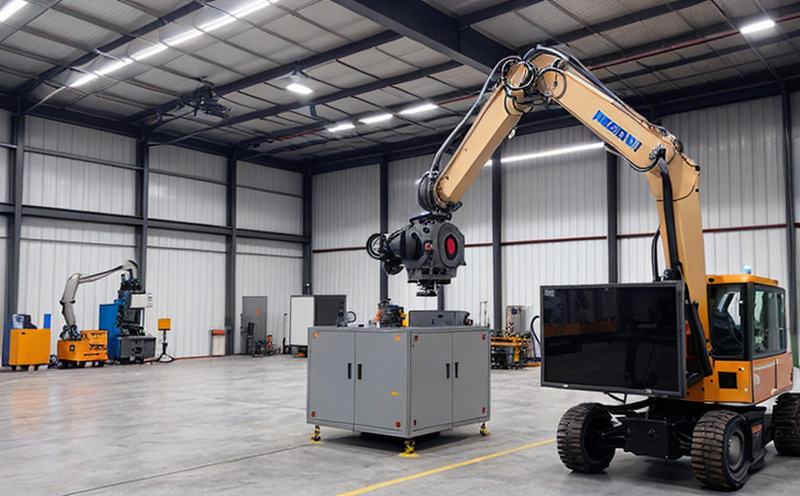ISO 9409 Mechanical Interface Compliance for Robot End-Effectors
The ISO 9409 standard is a cornerstone for ensuring compatibility and interchangeability of mechanical interfaces in robotic systems. This standard provides the framework necessary to test robot end-effectors, ensuring they meet design specifications and can be interchanged without compromising performance or safety.
Robotics and artificial intelligence (AI) are pivotal sectors driving innovation across manufacturing, healthcare, agriculture, and more. As these industries evolve, so too does the complexity of robotic systems. Ensuring that different components—such as end-effectors—can work seamlessly together is critical to maintaining operational efficiency and safety.
The mechanical interface described in ISO 9409 covers aspects such as mounting dimensions, fastening methods, and actuation mechanisms. Compliance with this standard ensures that robotic systems can be easily integrated into existing manufacturing lines or deployed across different facilities without additional customization. This is particularly important for industries where flexibility and scalability are key factors.
Our testing service adheres meticulously to the requirements outlined in ISO 9409, employing advanced test rigs capable of simulating real-world conditions that robots may encounter during operation. The rigging includes a variety of fixtures designed to mimic different types of robotic arms and end-effectors, enabling comprehensive evaluation across multiple dimensions.
One of the key aspects of our testing is ensuring dimensional accuracy. This involves precise measurement techniques using laser scanning and coordinate measuring machines (CMMs) to verify that all critical dimensions align perfectly with the ISO 9409 specifications. We also conduct functional tests, which involve simulating typical operational scenarios to assess whether the end-effector can be securely attached and detached from the robotic arm without causing damage.
Another crucial element is assessing the robustness of fastening methods. This includes evaluating bolts, screws, or clamps used to secure the end-effector. Our laboratory uses high-strength materials and applies rigorous stress tests to ensure that these connections can withstand the forces encountered during normal use without loosening or failing.
The safety aspect cannot be overstated in robotic systems. Compliance with ISO 9409 not only ensures mechanical compatibility but also contributes significantly to overall system safety. By ensuring that end-effectors fit securely and operate reliably, we help prevent accidents caused by misalignment or improper attachment. Our tests include verifying clearance distances between moving parts to avoid potential entanglements or collisions.
Our testing process is designed to be thorough yet efficient, providing clients with detailed reports outlining all test results against ISO 9409 criteria. These reports serve as valuable tools for quality assurance teams and R&D departments alike, offering insights into areas that may require further refinement or optimization.
In summary, our ISO 9409 compliance testing service is tailored to meet the rigorous demands of modern robotics and AI systems. By adhering strictly to this international standard, we ensure that robotic components are not only compatible with each other but also safe, reliable, and capable of performing their intended functions effectively.
Industry Applications
The application of ISO 9409 mechanical interface compliance testing extends across various sectors where robotic systems play a significant role. Here are some key industries benefiting from our specialized services:
- Automotive Manufacturing: Ensuring that robotic arms and end-effectors used in assembly lines can interchangeably fit different vehicles or components, enhancing efficiency and flexibility.
- Pharmaceuticals: In this sensitive sector, precise robotic systems are employed for packaging and quality control. ISO 9409 testing ensures these systems perform reliably without compromising product integrity.
- Hospitality & Food Processing: Robotic arms assist in handling fragile products like fruits or delicate foods. Compliance with ISO 9409 ensures these systems are robust enough to handle such materials safely and effectively.
- Agriculture: Autonomous robots are increasingly used for harvesting crops. Our testing helps ensure that robotic arms can securely attach and detach, optimizing performance in varying field conditions.
These examples illustrate how ISO 9409 mechanical interface compliance is essential across diverse industries, contributing to improved operational efficiency and enhanced safety standards.
International Acceptance and Recognition
The ISO 9409 standard enjoys widespread recognition and acceptance globally. Developed by the International Organization for Standardization (ISO), this standard has been adopted as a benchmark for mechanical interface design in robotic systems.
One of the reasons for its international appeal is the emphasis on universal compatibility, which facilitates seamless integration of robotic components across different manufacturers and applications. This interoperability reduces reliance on proprietary designs, fostering innovation while maintaining quality standards.
The standard has been recognized by major regulatory bodies around the world, ensuring that products conforming to ISO 9409 meet stringent safety and performance criteria. Compliance with this standard is particularly valuable for companies seeking to expand their market reach into international markets, as it signals adherence to globally accepted best practices.
Our laboratory’s expertise in implementing ISO 9409 testing aligns perfectly with these global trends. By offering comprehensive compliance services, we help manufacturers navigate the complexities of international standards and regulations. This ensures that their robotic systems not only meet local requirements but also perform consistently across various geographical locations.
Furthermore, adherence to internationally recognized standards like ISO 9409 enhances brand reputation by demonstrating a commitment to excellence in product design and manufacturing processes. It positions companies favorably in competitive markets where quality and reliability are paramount.
Use Cases and Application Examples
- Automotive Assembly Lines: Ensuring that robotic arms used for painting or welding can interchangeably attach to different car models without compromising precision.
- Pharmaceutical Packaging Robots: Testing the secure attachment of end-effectors designed to handle fragile medications, ensuring they do not cause damage during handling.
- Agricultural Harvesters: Evaluating robotic arms used for harvesting fruits or vegetables, verifying their ability to securely attach and detach from different types of machinery.
- Hospital Sterilization Robots: Assessing the robustness of end-effectors employed in sterilizing medical equipment, ensuring they can withstand repeated cycles without failure.
In each of these scenarios, ISO 9409 testing plays a crucial role, guaranteeing that robotic systems operate reliably and safely. This ensures industries can rely on consistent performance across various models and applications.





